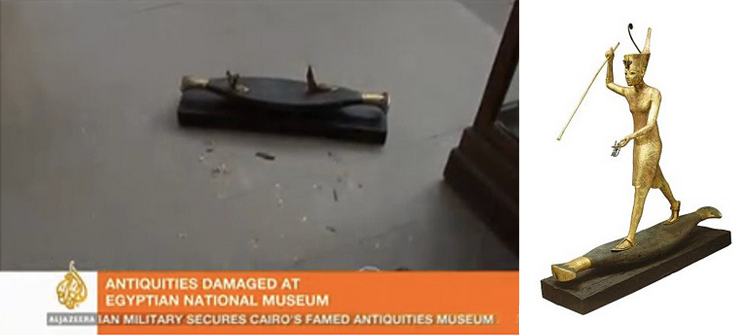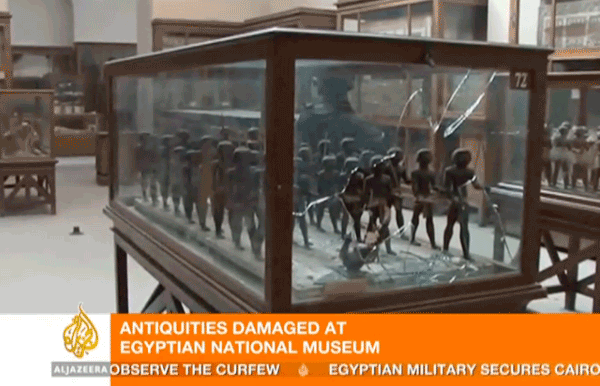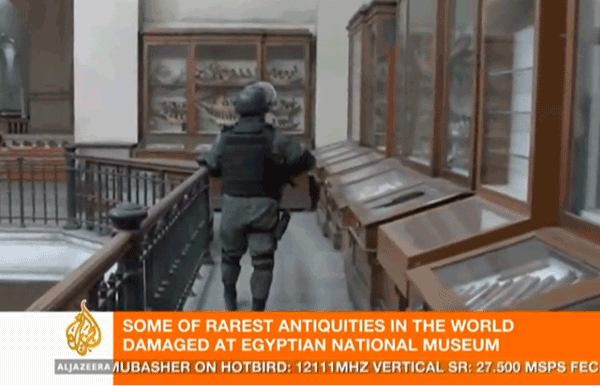
Museum Looting in Cairo
Amid the flood of news and images from Egypt's massive street protests, several reports came in Friday and Saturday on the destruction of ancient artifacts from Cairo's Egyptian National Museum.
The ruling party headquarters—located next door to the museum on Tahir Square, which has been a center for the protests of the past five days—was set on fire, raising fears that the flames could spread to the museum and destroy one of the world's greatest collections of ancient Egyptian artifacts. Then, on Friday evening, the museum was ransacked by looters; Zahi Hawass, Egypt's chairman of the Supreme Council of Antiquities, told CNN:
Some Egyptians who are criminals—they are not real Egyptians—entered, in the garden, the Cairo museum, and they [looted] the museum shop. And after that, nine of them entered from the fire-department staircase, the top of the museum, and, with ropes, they entered the museum. They opened thirteen cases from the Late Period, and when they found there was no gold, they threw antiquities on the ground. And they went only to King Tut's artifacts, and they opened only one case. They found a statue and they broke it into two pieces. We caught the nine people. They were caught by tourist police and Egyptian students, who tried to protect the museum. The army came, and they found with them the remains of two mummies, and they found also some small artifacts. And actually all the artifacts that have been [taken] from the museum, we can restore them. And the army now is protecting the museum. I can tell the world, through you: The Cairo Museum is safe. And that means, in my opinion: Egypt is going to be safe."
Al Jazeera and other networks broadcast footage of the destruction.
Margaret Maitland, a graduate student in Egyptology at Oxford, has been providing heartbreaking analysis of the footage, comparing the images of the destruction with historical photos of the artifacts in their original states:
And the art blog Hyperallergic is posting hourly updates on news regarding the museum—in fact, they've just posted a new link to an interview (in German) with the former director of the Egyptian Museum, Wafaa el-Saddik, who says that some of Friday's looters were apparently the museum's own guards—and that the Memphis Museum, near Cairo, has also been looted.
Rather than try to stay on top of this story's developments for the rest of the day, I'll simply urge readers to follow the news on the above-mentioned sites, and raise a few questions of my own.
The first is a question of ethics: in a city where the police have all but disappeared, and inmates have escaped from four prisons, how can the objects in a museum hold any sort of priority? Shouldn't all of Egypt's attention and resources focus on maintaining peace and order? This is, I hope, a false choice: achieving peace (and democracy) in Egypt, and protection of its cultural and archaeological heritage, should not be mutually exclusive. Could it be argued that peace and order are meaningless if the world's cultural and historical artifacts are thoughtlessly damaged or destroyed? I find myself a little appalled at my own priorities: how can I be chilled by the image of the splintered remains of the gilded statue of Tutankhamun as I'm also confronted with images of protesters suffering injuries from tear gas and rubber bullets? Art is supposed to deepen its viewers' capacity for empathy. Can a love of culture have the opposite effect, creating a monster (me) who values art above humanity? Please let me know ASAP.
In April 2003, after the U.S. invasion of Iraq, looters ransacked the Iraq Museum in Baghdad, and, despite a concerted effort to restore the stolen items—many even older than the treasures in the Egyptian Museum—thousands are still missing or destroyed. And even more damage has been done to Iraq's unprotected archeaological sites. Similar stories have unfolded in Afghanistan. Tanks and armored cars sealed off access to the pyramids on the Giza Plateau on Saturday. What will the fate of Egypt's historical sites be?
Who is responsible for these lootings? Wafaa el-Saddik, the former museum director, speculated that the museum guards looted the museum because they're so poorly compensated for their work. Some have argued that looting of stores and residences in Cairo was perpetrated by agents provacateurs—"party thugs," as reported by Al Jazeera—in an attempt to discredit and terrify the protestors. Was the museum actually looted by its own guards? Were they acting on behalf of the Egyptian regime? What motivated the looters to smash the display cases without taking the artifacts? Were they merely looking for gold?
In the end, the most important and moving images cannot be those of the destruction. They are instead the images that show civilians forming a human chain around the National Museum to protect it from further damage. In that photograph, the paradox of valuing human suffering over the preservation of irreplaceable art objects is, if not resolved, at least somewhat alleviated. The people in the human chain around the museum voluntarily protected the world's cultural heritage with their lives.
Projects

.jpg)











